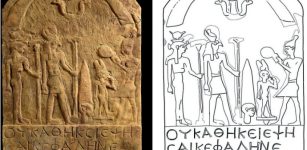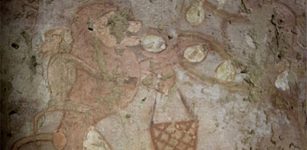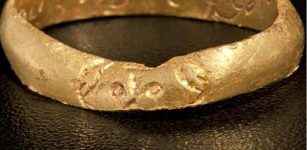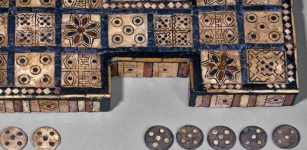Unraveling The Mystery Of The Phoenix Bird – Symbol Of The Sun And Eternal Rebirth Of Life
A. Sutherland - AncientPages.com - What is behind the story of Phoenix, the bird of immortality that rises from the ashes?
The Phoenix is known in various forms and names throughout the Middle and the Far East, the Mediterranean, and Europe. It is a symbol of resurrection.
Phoenix - Mythological Bird. In Greece, the phoenix rising from flames was the symbol of the First Hellenic Republic under Ioannis Kapodistrias, the Mountain Government and the Regime of the Colonels. Imge credit: Diafora - CC BY-SA 3.0
The name Phoenix may have come from the Greek phoînix and may be related to phoinos (blood-red).
In ancient Egypt, the Phoenix was called the "Lord of Jubilees" and was considered the ba (spirit) of the Sun God Ra. In Mesopotamia, the Phoenix is symbolized by the horned and winged solar disk. Alchemists used the Phoenix to represent the color red and the successful end of a process.
The medieval Hermeticists used the Phoenix as a symbol of alchemical transmutation.
Legends tell that the Phoenix had red and gold feathers, the rising Sun's color. It had a wonderfully melodious voice, which became mournful with approaching death. Other creatures were then so overcome by its beauty and sadness that they fell dead.
Ornament from a book of typographic specimens, 1870. Image source
From ancient texts, we learn that only one Phoenix could live at a time. Hesiod, the Greek poet, wrote that the Phoenix lived nine times the lifespan of the long-living raven. According to other sources, the Phoenix can live up to 97,200 years.
Tacitus (AD 56 – c. 120), a Roman historian and politician, is widely regarded as one of the prominent Roman historians by modern scholars. He said that "in the consulship of Paulus Fabius (AD 34), the miraculous bird known to the world by the name of the Phoenix, after disappearing for a series of ages, revisited Egypt. It was attended in its flight by various birds, all attracted by the novelty and gazing with wonder at its beautiful appearance."
Also, Herodotus' words are beautiful when he talks about the amazing Phoenix: "I have not seen it myself, except in a picture. Part of his plumage is gold-colored, and part crimson; and he is for the most part very much like an eagle in outline and bulk..."
 Egyptian Ba bird - the "ba," depicted as a human-headed falcon, was a spiritual aspect of one's personality. Image credit: Walters Art Museum - Public domain
Egyptian Ba bird - the "ba," depicted as a human-headed falcon, was a spiritual aspect of one's personality. Image credit: Walters Art Museum - Public domain
Pliny beliueved that there was to be only one Phoenix in the world, purple in color, with a golden head and a blue-pink tail, and with a crest of feathers on its head. He lived for 540 years, and then, it was time for him to built a nest of spices, in which he died. Tradition says that the Phoenix fed only on air, harming no other creature. It lived a solitary life in a faraway land, coming to a human-inhabited land only when it was ready to die. If the bird was injured, it possessed the power to heal itself.
When the Phoenix reaches the end of his life, it sets the nest and itself on fire and is burned to ashes. Shortly, the Phoenix rises again and begins its life anew. In some traditions, the new Phoenix gathers the old ashes and takes them to the Egyptian city of Heliopolis to offer them to the Sun God. The ashes laid on the Altar of the Sun are said to have the power to bring a dead man back to life.
When the Roman emperor Elagabalus (203-222) tried to become immortal, he dined off a bird of paradise, sent in place of a phoenix, but the substitute did not work. Instead, the emperor was murdered shortly afterward.
Death of the Phoenix burning in flames (medieval Aberdeen Bestiary). Image credit: Phoenix7777 - CC0 1.0
Unfortunately, there is little information about the Phoenix, the bird of flames.
Some people firmly believe that it is God's pet, let loose on the world now and again to give the people a glimpse of God's powers. Others swear that the Phoenix is a God, the incarnation of Foiros, bringing peace to the righteous and swift retribution to the evil and corrupt.
Yet another group says it is not more than a near-extinct animal, no different from a swan or dove. So far, scholars have been unable to trace the true origin of the Phoenix legend. It is believed, but not confident, that the legend came from the Orient and was adopted by Sun-worshipping priests of Heliopolis as an allegory of the Sun's daily setting and rebirth.
In Christianity, the resurrected Phoenix became a famous symbol for how Jesus Christ has risen from the grave.
The legend of this beautiful supernatural creature has survived for centuries. The Phoenix never died permanently. Legend says it existed when the universe was created.
It knows the secrets of life and reincarnation, knowledge even the most powerful gods do not possess.
Written by – A. Sutherland - AncientPages.com Senior Staff Writer
Updated on November 6, 2023
Copyright © AncientPages.com All rights reserved. This material may not be published, broadcast, rewritten or redistributed in whole or part without the express written permission of AncientPages.com
Expand for referencesReferences:
Nigg J. The Phoenix: An Unnatural Biography of a Mythical Beast
Bulfinch, Thomas. Bulfinch's Mythology
Pliny the Elder: Natural History, Books XXX
More From Ancient Pages
-
 Smallest Arm Bone In Human Fossil Record Illuminates Homo Floresiensis Origin
Archaeology | Aug 7, 2024
Smallest Arm Bone In Human Fossil Record Illuminates Homo Floresiensis Origin
Archaeology | Aug 7, 2024 -
 We Dated A Sacred Aboriginal Women’s Site Used for Birthing Ceremonies And Discovered 7,000 Years Of Tool Making
Featured Stories | Jun 21, 2024
We Dated A Sacred Aboriginal Women’s Site Used for Birthing Ceremonies And Discovered 7,000 Years Of Tool Making
Featured Stories | Jun 21, 2024 -
 Cog Stones – Unusual Stone Discs Made By An Ancient Lost Civilization In California
Artifacts | Jan 4, 2018
Cog Stones – Unusual Stone Discs Made By An Ancient Lost Civilization In California
Artifacts | Jan 4, 2018 -
 On This Day In History: Raid On The Medway Took Place – On June 19, 1667
News | Jun 19, 2016
On This Day In History: Raid On The Medway Took Place – On June 19, 1667
News | Jun 19, 2016 -
 Why Did Vikings Carry Decorative Swords That Were Useless In Combat?
Ancient History Facts | Jun 8, 2024
Why Did Vikings Carry Decorative Swords That Were Useless In Combat?
Ancient History Facts | Jun 8, 2024 -
 How Human Ancestors Used Fire – New Methods Give Answers
Archaeology | Nov 2, 2022
How Human Ancestors Used Fire – New Methods Give Answers
Archaeology | Nov 2, 2022 -
 Archaic Temple (Part Of God Poseidon’s Sanctuary) At The Kleidi-Samikon Site In Greece – Unearthed
Archaeology | Jan 12, 2023
Archaic Temple (Part Of God Poseidon’s Sanctuary) At The Kleidi-Samikon Site In Greece – Unearthed
Archaeology | Jan 12, 2023 -
 Elusive Celtic Otherworld Where Tuatha Dé Danann Reside And Time Passes Slower
Celtic Mythology | Apr 7, 2018
Elusive Celtic Otherworld Where Tuatha Dé Danann Reside And Time Passes Slower
Celtic Mythology | Apr 7, 2018 -
 Denisovan DNA Found In The Genome Of Oldest Human Fossil Discovered In Mongolia
Archaeology | Oct 30, 2020
Denisovan DNA Found In The Genome Of Oldest Human Fossil Discovered In Mongolia
Archaeology | Oct 30, 2020 -
 6,000-Year-Old Earth Ovens Discovered In Washington State
Archaeology | Jun 21, 2023
6,000-Year-Old Earth Ovens Discovered In Washington State
Archaeology | Jun 21, 2023 -
 Shrine Discovered In Egyptian Temple And Evidence Of Previously Unknown Rituals
Archaeology | Oct 6, 2022
Shrine Discovered In Egyptian Temple And Evidence Of Previously Unknown Rituals
Archaeology | Oct 6, 2022 -
 Ancient Maya People Used Volcanic Ash To Build Pyramids When Huge Eruption Occurred
Archaeology | Sep 22, 2021
Ancient Maya People Used Volcanic Ash To Build Pyramids When Huge Eruption Occurred
Archaeology | Sep 22, 2021 -
 Tomb Of Hathor’s Priestess Hetpet Unearthed Near Pyramid Of Khafre, Cairo, Egypt
Archaeology | Feb 5, 2018
Tomb Of Hathor’s Priestess Hetpet Unearthed Near Pyramid Of Khafre, Cairo, Egypt
Archaeology | Feb 5, 2018 -
 Dwarfie Stane: Mysterious 5,000-Year-Old Rock-Cut Tomb On Dark Enchanted Island Of Hoy, Scotland
Featured Stories | Feb 21, 2023
Dwarfie Stane: Mysterious 5,000-Year-Old Rock-Cut Tomb On Dark Enchanted Island Of Hoy, Scotland
Featured Stories | Feb 21, 2023 -
 University Of Warsaw Archaeologists Return To Study Large Ancient City Of Ptolemais
Archaeology | Sep 8, 2023
University Of Warsaw Archaeologists Return To Study Large Ancient City Of Ptolemais
Archaeology | Sep 8, 2023 -
 Egyptian Priest Sonchis Of Sais And His Story About Atlantis – Were The Shemsu Hor Survivors Of A Great Catastrophe That Ended The Ice Age?
Ancient Mysteries | Jun 8, 2017
Egyptian Priest Sonchis Of Sais And His Story About Atlantis – Were The Shemsu Hor Survivors Of A Great Catastrophe That Ended The Ice Age?
Ancient Mysteries | Jun 8, 2017 -
 Skulls and inscriptions on three rings found by archaeologists in Wales
Artifacts | Aug 29, 2015
Skulls and inscriptions on three rings found by archaeologists in Wales
Artifacts | Aug 29, 2015 -
 Illapa: Powerful Master Of Clouds, Rain And Hail – Worshipped By Inca People
Featured Stories | Jul 7, 2016
Illapa: Powerful Master Of Clouds, Rain And Hail – Worshipped By Inca People
Featured Stories | Jul 7, 2016 -
 Huge 2,000-Year-Old Roman Basilica Discovered In Israel May Have Been Built By Herod The Great
Archaeology | Jul 29, 2021
Huge 2,000-Year-Old Roman Basilica Discovered In Israel May Have Been Built By Herod The Great
Archaeology | Jul 29, 2021 -
 Royal Game Of Ur – One Of The Oldest Game Boards Discovered
Ancient History Facts | Feb 3, 2016
Royal Game Of Ur – One Of The Oldest Game Boards Discovered
Ancient History Facts | Feb 3, 2016



